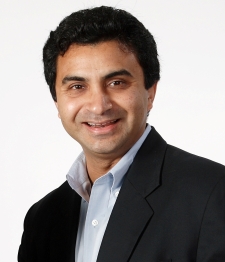|
2012 IFAAMAS Award for Influential Papers in Autonomous Agents and Multiagent Systems
|
|
Michael P. Wellman (University of Michigan)
|
|

Michael P. Wellman is Professor of Computer Science & Engineering at the University of Michigan.
He received a PhD from the Massachusetts Institute of Technology in 1988 for his work in qualitative probabilistic reasoning and decision-theoretic planning. From 1988 to 1992, Wellman conducted research in these areas at the USAF’s Wright Laboratory. For the past 19+ years, his research has focused on computational market mechanisms for distributed decision making and electronic commerce.
As Chief Market Technologist for TradingDynamics, Inc. (now part of Ariba), he designed configurable auction technology for dynamic business-to-business commerce. Wellman previously served as Chair of the ACM Special Interest Group on Electronic Commerce (SIGecom), and as Executive Editor of the Journal of Artificial Intelligence Research. He is a Fellow of the Association for the Advancement of Artificial Intelligence and the Association for Computing Machinery.
|
|
A market-oriented programming enviornment and its application to distributed multicommodity flow problems
(Journal of Artificial Intelligence Research, Volume 1, pages 1-23, 1993
http://www.jair.org/papers/paper2.html)
ABSTRACT:
Market price systems constitute a well-understood class of mechanisms that under certain conditions provide effective decentralization of decision making with minimal communication overhead. In a market-oriented programming approach to distributed problem solving, we derive the activities and resource allocations for a set of computational agents by computing the competitive equilibrium of an artificial economy. WALRAS provides basic constructs for defining computational market structures, and protocols for deriving their corresponding price equilibria. In a particular realization of this approach for a form of multicommodity flow problem, we see that careful construction of the decision process according to economic principles can lead to efficient distributed resource allocation, and that the behavior of the system can be meaningfully analyzed in economic terms..
|
|
Milind Tambe (University of Southern California (USC))
|

Milind Tambe is a Professor of Computer Science and Industrial and Systems Engineering at the University of Southern California(USC). He leads the TEAMCORE Research Group at USC, with research focused on agent-based and multi-agent systems. He is a fellow of AAAI (Association for Advancement of Artificial Intelligence) and recipient of the ACM (Association for Computing Machinery) "Autonomous Agents Research Award".
He is also the recipient of the Christopher Columbus Fellowship Foundation Homeland security award, the Rist Prize of the Military Operations Research Society, a "most influential paper award" from the International Foundation for Agents and Multiagent Systems, US First Coast Guard District's Operational Excellence Award, Certificate of Appreciation from the US Federal Air Marshals Service, special commendation given by the Los Angeles World Airports police from the city of Los Angeles, USC Viterbi School of Engineering use-inspired research award, Okawa foundation faculty research award, the RoboCup scientific challenge award, USC Steven B. Sample Teaching and Mentoring award and the ACM recognition of service award.
Prof. Tambe and his research group's papers have been selected as best papers at a dozen premier Artificial Intelligence and Operations Research Conferences and workshops; these have included best paper awards at the International Conference on Autonomous Agents and Multiagent Systems and International Conference on Intelligent Virtual Agents. Additionally, algorithms developed by his Teamcore research group have been deployed for real-world use by several agencies including the LAX police, the Federal Air Marshals service, the US Coast Guard and the Transportation security administration. He received his Ph.D. from the School of Computer Science at Carnegie Mellon University.
|
|
Towards Flexible Teamwork
(Journal of Artificial Intelligence Research, Volume 7, pages 83-124, 1997.
http://www.jair.org/papers/paper433.html )
ABSTRACT:
Many AI researchers are today striving to build agent teams for complex, dynamic multi-agent domains, with intended applications in arenas such as education, training, entertainment, information integration, and collective robotics. Unfortunately, uncertainties in these complex, dynamic domains obstruct coherent teamwork. In particular, team members often encounter differing, incomplete, and possibly inconsistent views of their environment. Furthermore, team members can unexpectedly fail in fulfilling responsibilities or discover unexpected opportunities. Highly flexible coordination and communication is key in addressing such uncertainties. Simply fitting individual agents with precomputed coordination plans will not do, for their inflexibility can cause severe failures in teamwork, and their domain-specificity hinders reusability.
Our central hypothesis is that the key to such flexibility and reusability is providing agents with general models of teamwork. Agents exploit such models to autonomously reason about coordination and communication, providing requisite flexibility. Furthermore, the models enable reuse across domains, both saving implementation effort and enforcing consistency. This article presents one general, implemented model of teamwork, called STEAM. The basic building block of teamwork in STEAM is joint intentions (Cohen & Levesque, 1991b); teamwork in STEAM is based on agents' building up a (partial) hierarchy of joint intentions (this hierarchy is seen to parallel Grosz & Kraus's partial SharedPlans, 1996). Furthermore, in STEAM, team members monitor the team's and individual members' performance, reorganizing the team as necessary. Finally, decision-theoretic communication selectivity in STEAM ensures reduction in communication overheads of teamwork, with appropriate sensitivity to the environmental conditions. This article describes STEAM's application in three different complex domains, and presents detailed empirical results.
|
|